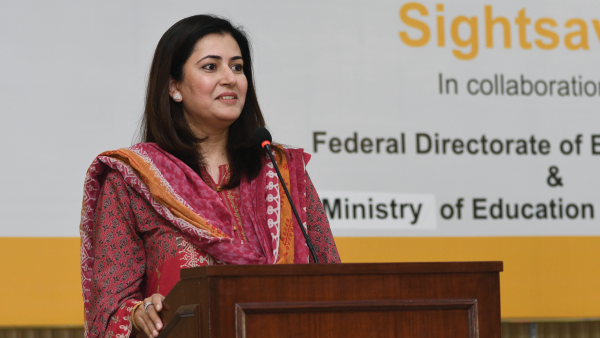Transforming the Transition Lens
A closer look at the “fastest dark lens” in the clear-to-dark photochromic category
Five-years ago, a team of scientists and engineers from Transitions Optical questioned whether it would be possible to create a synergy of speed and darkness without sacrificing one for the other in transition lenses. This was in direct response to a recurring consumer criticism regarding the lens’ slow transition time from clear to dark and vice versa.
As expected when creating something new, the scientists’ progress was anything but linear, involving manufacturing challenges, color palette complexities, and countless lens tests. But with perseverance they finally came up with a solution: Transitions GEN S – a lens capable of darkening in just three seconds and reversing in less than two minutes.
We sat down with Brian O’Neill, Global Vice President of Innovation, Technology and Operations at Transitions Optical, to learn more.
Why is light management important in vision care?
Traditional measures of vision quality focus on achieving 20/20 visual acuity through static clear lenses under stable lighting. These lenses correct refractive errors for sharp vision, but can overlook the complexities of real-world lighting conditions.
It’s no secret that light profoundly influences how we perceive our surroundings, and that changes in light levels can significantly affect visual acuity, contrast sensitivity, and even the time it takes for our vision to adjust. As a result, static lenses can fall short in scenarios where light varies – such as bright environments where quick adjustments are necessary to maintain clarity but are challenging due to the direct impact of intense light on retinal vision mechanisms. Conversely, insufficient light or fluctuations in lighting can impair vision, prolonging the adaptation process and reducing overall visual performance.
What can you tell us about your new lens technology?
Our efforts into light reactive lenses began at the molecular level; we developed a technology that could ensure interaction between dyes and matrix in wearable glasses. Simply speaking, dyes absorb light energy quickly, which, in turn, facilitates fast activation and fading. Whereas the matrix improves dye performance and the overall rigidity of the system.
With over 450 prototypes and 100,000 tested lenses, we now finally have our patented formula. Unlike traditional prescription lenses, Transitions lenses can adjust their tint according to the level of UV light exposure to provide wearers with both visual comfort and protection.
What have been the challenges in developing these lenses?
We faced several challenges throughout the development cycle. For example, our manufacturing processes, which have worked for previous generations, were no longer capable of consistently producing this new technology. We then tested and modified many different process variables to find the optimal conditions. And, once a final process was defined, our team of scientists and engineers experimented with tens of thousands of lenses to ensure it could be produced at a consistent level.
Another challenge was getting consistent color throughout both the activation and fade cycles. In addition to focusing on developing a set of light intelligent dyes that activate to the desired color, our team of dye and formulation scientists had to develop dyes with performance properties that, when combined, would work perfectly in unison throughout both the activation and fade cycles of the lens. This huge effort required the design and synthesis of many different dye molecules to identify the ideal candidates, as well as hundreds of prototype lenses.
Finally, the development of our new ruby lens offered its own technological challenges. This particular color is new for Transitions GEN S and was notably difficult to achieve. Even with a dye library of over 7,000 dyes, we couldn’t identify a suitable candidate that could deliver the desired red color. Again, the dye and formulation scientists had to go back to the beginning and synthesize a unique dye to use in the final ruby formulation.
What should opticians and optometrists know about GEN S lenses?
Most importantly, this is our fastest dark lens in the clear to dark category. It takes approximately three seconds to darken and less than two minutes to fade back. Secondly, it has the broadest color range ever, with eight different tones to choose from.
In intense bright light situations, our research shows that the lens provides a 39 percent faster vision recovery time when compared with clear lenses. The GEN S lens also provides a 40 percent faster vision recovery time during fadeback when compared to the previous generation. This, ultimately, means less waiting for eyes to adapt.
Can you make any predictions about the future of this technology?
In the next decade, I believe photochromic technology will experience significant advancements in materials science, dye and matrix technologies, and maybe even artificial intelligence (AI). By embracing new technologies, like AI and machine learning, it may become possible to create smart algorithms that can analyze a user’s visual habits, light sensitivity, and lifestyle factors to improve the overall performance of light intelligent lenses in real-time.
I also expect the industry to shift towards biodegradable and sustainable options in alignment with the world’s increasing environmental concerns. Furthermore, advances in manufacturing techniques may yield ultra-thin and lightweight photochromic lenses that not only enhance comfort and aesthetics, but also minimize waste.
The New Optometrist Newsletter
Permission Statement
By opting-in, you agree to receive email communications from The New Optometrist. You will stay up-to-date with optometry content, news, events and sponsors information.
You can view our privacy policy here
Most Popular
Sign up to The New Optometrist Updates
Permission Statement
By opting-in, you agree to receive email communications from The New Optometrist. You will stay up-to-date with optometry content, news, events and sponsors information.
You can view our privacy policy here
Sign up to The New Optometrist Updates
Permission Statement
By opting-in, you agree to receive email communications from The New Optometrist. You will stay up-to-date with optometry content, news, events and sponsors information.
You can view our privacy policy here







